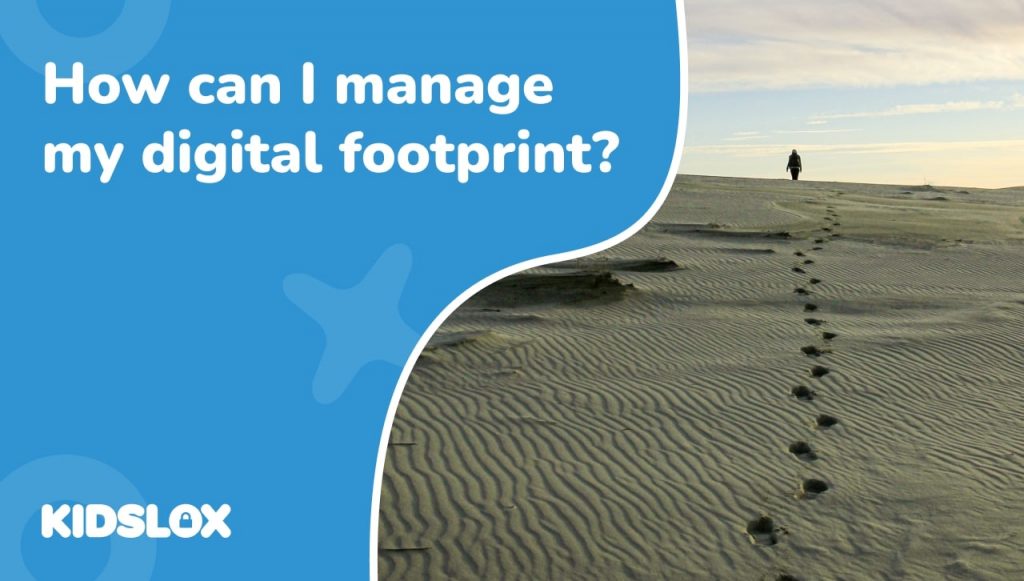Everything you need to know about the trail you leave online.
Our interactions with the digital world are a big part of our daily lives, and they leave a mark; our digital footprint. It’s an invisible trail that stays with us behind with every click, like, share, or post we make online. This virtual breadcrumb trail is more significant than we often realize and carries potential consequences that can impact both our online and offline lives.
As we navigate through various digital platforms, from social media to online shopping sites, news portals to digital communication tools, we continuously leave behind our mark. Understanding what constitutes our digital footprint, the types, its implications, how it works, what it means for children, and how to manage it responsibly is crucial in our tech-dominated society.
In this comprehensive guide, we will explore what a digital footprint means, its types and examples, its impacts, and the ways to protect it. Whether you are a concerned parent wanting to protect your child or grappling with the complexities of the digital world yourself, this guide will equip you with essential knowledge about your digital footprint.
What Does ‘Digital Footprint’ Mean?
In simple terms, a digital footprint is the trail of data you create while using the internet. It encompasses everything from the websites you visit to the emails you send and the social media posts you interact with. Essentially, every single action you take online leaves a digital mark, contributing to your overall digital footprint.
There are two main types of digital footprints: active and passive. Let’s look at both in a little more detail.
Active Digital Footprint:
Your active digital footprint is all of the digital traces you consciously leave online. Every time you post a photo on Instagram, write a blog post, comment on a YouTube video, or send an email, you’re contributing to your active digital footprint. These actions are deliberate, and you’re aware that you’re leaving a trail behind.
Passive Digital Footprint:
This is the data collected about you without you directly initiating the action. This includes things like your browsing history, location data tracked by apps, or cookies on the websites you visit. For example, when you read an article online, the website might store information about your visit duration, the type of device you’re using, your location, and more.
Both active and passive digital footprints form an integral part of your overall digital presence. They each carry significant implications and can paint a comprehensive picture of your online behavior, preferences, and habits.
For example, your active digital footprint could reveal your interests, opinions, and social connections. In contrast, your passive digital footprint could disclose your browsing patterns, location history, or even your shopping preferences.
Understanding the distinction between active and passive digital footprints is crucial. It helps us better grasp the extent of our digital trail and the various factors contributing to it. Awareness is the first step towards responsible digital citizenship, which involves managing our digital footprints to safeguard your privacy and online reputation and that of your kids too.
But what does that look like? To better grasp the concept, it’s helpful to understand some concrete examples of a digital footprint.
Social Media Interactions: Every time you post a status update on Facebook, tweet on Twitter, or share a picture on Instagram, you’re leaving an active digital footprint. Even the comments you make, the posts you like or share, contribute to your active footprint.
Emails and Instant Messages: The emails you send through Gmail, the messages you exchange on WhatsApp, or the chats you have on Facebook Messenger – all these communications leave a digital trail.
Online Shopping: The items you purchase on Amazon, the reviews you write, or even the products you browse contribute to your active digital footprint.
Website Cookies: Websites often store small files, known as cookies, on your device to remember information about your visit. This could include details like the items you added to your cart, the pages you visited, or your login information.
Internet Service Providers (ISPs): ISPs track and store data about your internet usage, including the websites you visit and the duration of your visits. This is a significant source of passive digital footprint.
Location Tracking: Many smartphone apps track your location data, sometimes even when you’re not actively using the app. This data can reveal your commuting patterns, the places you frequent, and even your home and work addresses.
While these examples might seem unrelated, together they form a detailed portrait of your online identity. That’s why understanding your digital footprint and the ways in which it’s formed is so crucial. In the digital age, information is power, and your digital footprint can be used to inform the ads you see, the content you are served and more.
Should I be worried about the impact of my digital footprint?
Once you engage with the online world, either passively or actively, the digital footprint you make will have an impact. It’s crucial that you understand how, and pass the knowledge on within your family, so that kids also understand the implications of their digital activity and how best to safeguard their privacy and experience online.
The pros of having a digital footprint
Personal Branding: Professionally, a well-managed digital footprint can enhance your personal brand. By sharing your skills, achievements, and insights online, you can attract opportunities and build a strong reputation – whether that’s academic or professional.
Networking: Your digital footprint can help you connect with like-minded individuals and groups, opening up avenues for collaboration, learning, and growth.
Influence: As you build your digital presence, you can wield influence in your areas of interest. Whether it’s promoting a cause you’re passionate about or sharing your expertise, your digital footprint can give you a voice.
Tailored experiences: Digital footprints help personalise our experience online, whether that’s the advertisements we see or the content that’s served to us. Advancements in A.I. is making this even more common, but there is a downside. Many commentators believe that this creates an echo chamber where we’re not exposed to new ideas and opinions.
Is there a negative side to my digital footprint?
Privacy Concerns: An unmanaged digital footprint can expose sensitive personal information, making you susceptible to data breaches and identity theft.
Online Reputation: Inappropriate or impulsive posts can harm your online reputation. Potential employers often scan digital footprints, and negative content can affect job prospects and other opportunities.
Cyberbullying: Sharing personal details or controversial views can sometimes lead to cyberbullying or harassment, impacting on a person’s quality of life and mental health.
Understanding these impacts is crucial to managing your digital footprint responsibly. It is important to remember that once information is online, it is challenging (and in a lot of cases, impossible) to completely erase it. This is a key when teaching your children about responsible internet use and digital citizenship.
Every online action contributes to building your digital identity, so it’s worth considering what your digital footprint says about you. Always ask yourself:
- Are you sharing content that aligns with your values?
- Are you protecting your private information?
- Are you interacting positively and respectfully with others?
What are the consequences if I don’t manage my digital footprint properly?
While our digital footprints can serve us in positive ways, they also come with a slew of potential consequences if not managed responsibly. It’s important to ensure teens understand that their digital footprint is created with every action they make online, and that whatever they post or share will follow them forever.
Here are some examples of how a careless digital footprint can have serious consequences for the rest of your life:
Online Reputation Damage: Your digital footprint paints a portrait of who you are online. Negative or inappropriate content, comments, or interactions can tarnish your online reputation, impacting both your personal and professional life.
Loss of Opportunities: Many employers and universities now look at digital footprints as part of their decision-making process. Negative digital footprints can lead to missed job opportunities or college admissions.
Privacy Breaches: Poorly managed digital footprints can expose personal data, leading to privacy breaches. This could potentially result in identity theft, cyberstalking and more.
Legal Consequences: In some cases, your online activities could have legal repercussions. For instance, posting copyrighted material, engaging in online harassment, or sharing defamatory content could result in legal action.
How to manage your digital footprint and tips for helping kids to understand its importance
In the digital age, protecting your digital footprint is akin to protecting your identity. Children are especially vulnerable as they spend so much of their spare time online and can sometimes get carried away, posting before they think.
Apps like Snapchat encourage throw-away content, which may lead children to take risks with what they post. Teens might not also connect the dots when it comes to the lasting legacy of their online interactions and how a throw-away comment could put off a potential employer or school.
Responsible internet use should form a part of everybody’s online life, and teaching children early about how to put this into practice means that it becomes second nature.
Here are some practical steps you can take to manage and protect your, and your family’s, digital footprint effectively:
- Be Mindful of What You Share: Think twice before you post or comment online. Remember, what goes on the internet often stays on the internet. It’s also essential to be cautious when sharing sensitive personal information like your home address, phone number, or financial details.
- Adjust Privacy Settings: Ensure that you fully understand and utilize the privacy settings on the social media platforms and online services you use. These settings allow you to control who can see your posts and how your data is used. Ensure your children know never to give out identifying or sensitive information about their life, school or family to anyone else on the internet.
- Regularly Monitor Your Online Presence: Use a digital footprint checker to regularly monitor your online presence. If you find outdated or undesirable content, take necessary steps to remove it or minimize its visibility.
- Use Strong and Unique Passwords: To protect your accounts from being hacked, use strong, unique passwords for each of your online accounts. Consider using a password manager to help you manage them.
- Be Aware of Phishing Scams: Be vigilant about phishing scams, which often attempt to trick you into providing your login credentials or other sensitive information.
- Limit Use of Third-Party Logins: When possible, avoid using third-party logins (such as signing into a new service through Facebook or Google). Each of these connections creates a point of data exchange that could potentially be exploited.
- Use a VPN: Virtual Private Networks (VPNs) can provide an extra layer of security by masking your IP address, making your online activity harder to track.
Remember, managing your digital footprint is an ongoing process. By being proactive and diligent, you can create a positive and safe digital presence.
A good place to start is by doing a check of what your, or your children’s existing digital footprint looks like. You can do this with free tools, or by signing up to a dedicated digital footprint checker, which can give you more detailed information.
1. Start with a simple search
To get an idea of the extent of your digital footprint, you can start with a simple Google search of your own, or your child’s name. This could give you a quick overview of the information readily available online.
2. Use a digital footprint checker
For a more detailed insight, you can use a digital footprint checker. These tools are designed to explore the internet and compile a comprehensive overview of your online presence across various platforms. They can track your social media accounts, forum posts, blog entries, and even comments you’ve made on different websites.
While these tools can provide an overview, they may not capture every detail of your digital footprint, especially those parts considered a passive digital footprint like cookies or browsing history.
By using these resources, you can identify outdated or unwanted information about yourself or a family member online and take steps to manage it. This could involve updating your privacy settings on social platforms, removing unwanted posts, or even contacting website administrators to request the removal of specific content.
Navigating the Digital World Responsibly
In today’s connected world, our digital footprints have become an integral part of our identities. While the digital realm offers limitless opportunities for learning, connection, and growth, it also calls for responsibility – and educating our children on how they should behave online too.
If you’re worried about your child’s behavior online, and want to be more proactive in supporting them with keeping their digital footprint clean, Kidslox can help. With features like ‘Telescope’, which gives you an on-demand view of their cellphone plus daily activity round-ups, the ability to block content, apps and set reasonable time limits for being online, you have another pair of hands in your pocket to help.




